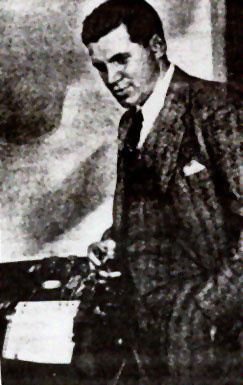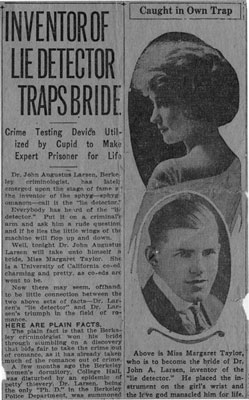Basically speaking, the polygraph is a simple detector device that monitors the changes in the body when a person is speaking. It is a common and traditional belief that changes occur in the body when a person is lying. Some examples are the heart beating faster, the person breaking into a sweat, the mouth becoming dry, etc. The polygraph tries to monitor all these changes. The principle is simple - if the person is speaking the truth, all these changes won't occur. But if the person is lying, then these changes are bound to happen, and that's what the polygraph picks up.


However, to its credit, I must say that investigators were so impressed by this detective aid that they immediately began informally using it. August Vollmer of the Berkeley Police Department was known to often use polygraph testing in his investigations. And the polygraph did not take long to spread throughout the US and eventually worldwide. Investigation is always such a tedious process that detectives would welcome anything to ease their burden anyway.
Today's polygraph monitors three vital symptoms of the human body in an attempt to find out if the person is lying. These three systems are the circulation system, the sweat producing system and the respiratory system. Thus, it contains three detectors, which are connected to the fingers (for monitoring changes in sweat production), to the chest (for monitoring changes in breathing) and at any suitable place on the body to determine changes in circulation of blood. The output can be either produced on traditional pen and paper, on a computer monitor. In both kinds of devices, the results are recorded and are quite easily understandable.
Let us now see how a typical polygraph testing is conducted.
A session of polygraph testing can last from one to three hours. It is not necessary that the polygraph testing will always provide authentic results. The expert will sometimes have to make deductions from the results obtained during the interviews. In order to make the procedure simpler to both the examiner and the examinee, the total interview is broken down into three parts. They are simply called the pre-test, the test and the post-test. During the pre-test, the necessary paperwork is completed and the examiner explains to the examinee how the test works. Sometimes, the examiner will also indicate what kinds of questions he or she will ask of the examinee during the test. When the test really begins, these questions are asked in detail. This is the period when the polygraph testing results become really significant. This is also the longest part of the interview. Finally, the interview peters down to the post-test phase, when the examiner finishes asking the questions, which might be mostly confirmative questions of those asked earlier.
Based on the results of the polygraph test, the examiner will give a verdict. The verdict can be either Not Guilty to Guilty, but then there are also Inconclusive results given out if the results of the test are not so very clear. The examiner can also form a No Opinion conclusion, especially if the test had to be terminated midway.
Of course, errors are rampant. Lie detection through a polygraph leans heavily on the premise that the person will show some definite physical changes which can be recorded. But, in hardcore liars (sorry, no better word!), the polygraph test will fail. Such people will have a way to cheat the lie detector test, because they know exactly what the examiners are looking for.
There's one more reason why polygraph testing must not be relied on. In people who have a high guilty conscience, the polygraph will record a false positive test (means a guilty result when the person is actually not guilty). A person's heart may beat faster or he or she may perspire simply because of the fear of the law.


Professinal lie detector kit
The polygraph has undergone a lot of changes since the first crude design created by Dr. John A. Larson of the University of California in 1920.| John A. Larson | |
|---|---|
| Born | 11 December 1892 Shelburne, Nova Scotia, Canada |
| Died | 1 October 1965 Berkeley |
| Residence | Berkeley, California |
| Citizenship | U.S. |
| Nationality | American |
| Fields | Medicine Criminology |
| Alma mater | University of California, Berkeley |
| Known for | Criminology, Polygraphy |

However, to its credit, I must say that investigators were so impressed by this detective aid that they immediately began informally using it. August Vollmer of the Berkeley Police Department was known to often use polygraph testing in his investigations. And the polygraph did not take long to spread throughout the US and eventually worldwide. Investigation is always such a tedious process that detectives would welcome anything to ease their burden anyway.
Today's polygraph monitors three vital symptoms of the human body in an attempt to find out if the person is lying. These three systems are the circulation system, the sweat producing system and the respiratory system. Thus, it contains three detectors, which are connected to the fingers (for monitoring changes in sweat production), to the chest (for monitoring changes in breathing) and at any suitable place on the body to determine changes in circulation of blood. The output can be either produced on traditional pen and paper, on a computer monitor. In both kinds of devices, the results are recorded and are quite easily understandable.
Let us now see how a typical polygraph testing is conducted.
A session of polygraph testing can last from one to three hours. It is not necessary that the polygraph testing will always provide authentic results. The expert will sometimes have to make deductions from the results obtained during the interviews. In order to make the procedure simpler to both the examiner and the examinee, the total interview is broken down into three parts. They are simply called the pre-test, the test and the post-test. During the pre-test, the necessary paperwork is completed and the examiner explains to the examinee how the test works. Sometimes, the examiner will also indicate what kinds of questions he or she will ask of the examinee during the test. When the test really begins, these questions are asked in detail. This is the period when the polygraph testing results become really significant. This is also the longest part of the interview. Finally, the interview peters down to the post-test phase, when the examiner finishes asking the questions, which might be mostly confirmative questions of those asked earlier.
Based on the results of the polygraph test, the examiner will give a verdict. The verdict can be either Not Guilty to Guilty, but then there are also Inconclusive results given out if the results of the test are not so very clear. The examiner can also form a No Opinion conclusion, especially if the test had to be terminated midway.
Of course, errors are rampant. Lie detection through a polygraph leans heavily on the premise that the person will show some definite physical changes which can be recorded. But, in hardcore liars (sorry, no better word!), the polygraph test will fail. Such people will have a way to cheat the lie detector test, because they know exactly what the examiners are looking for.
There's one more reason why polygraph testing must not be relied on. In people who have a high guilty conscience, the polygraph will record a false positive test (means a guilty result when the person is actually not guilty). A person's heart may beat faster or he or she may perspire simply because of the fear of the law.
The Legacy
Larson married Margaret Taylor, the freshman victim of the College Hall case and the first person he ever interrogated on the lie detector. Over the next fifteen years, he collected hundreds of files on successful criminal cases where his polygraph solved murders, robberies, thefts and sex crimes. His instrument was nicknamed 'Sphyggy' by the press who covered Larson’s crime solving escapades in the 1920’s and 30's; 'Sphyggy' because they couldn’t pronounce 'Sphygmomanometer.' [9] The polygraph is considered officially one of the greatest inventions of all time. It is included in theEncyclopædia Britannica Almanac 2003's list of 325 greatest inventions,[10] and is still ranks at 10 in the Rankopedia’s Best Inventions of 1920’s.[11] This first polygraph instrument of Larson is now at the Smithsonian Institution in Washington, D.C.. It first appeared in action in a moving picture in 1926 in the silent police serial ‘’Officer 444’’.

edit]
India
Recently an Indian court adopted the brain electrical oscillations signature test as evidence to convict a woman, who was accused of murdering her fiance. It is the first time that the result of polygraph was used as evidence in court.[55] On May 5, 2010, The Supreme Court of India declared use of narcoanalysis, brain mapping and polygraph tests on suspects as illegal and against the constitution.[56]Article 20(3) of the Indian Constitution-"No person accused of any offence shall be compelled to be a witness against himself." Polygraph tests are still legal if the defendant requests one, however.



The reliability of the test results are arguably correct. However one cannot infringe on the personal integrty of a perso and the fear of the test itself can produce a false positive test.
ReplyDeleteRajan